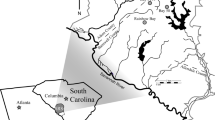Abstract.
We investigated the short-term and long-term effects of copper and zinc on horseshoe crab (Limulus polyphemus) embryos and first instar larvae from two estuaries in New Jersey, Delaware Bay and Sandy Hook Bay. Animals were exposed to nominal metal concentrations from 0.01 to 1,000 mg/L for 24 h, 48 h, 72 h, or continuously until the endpoint for the study (successful molting or death) was reached. Larvae showed greater tolerance of Cu and Zn than embryos. Under most treatment regimes, embryos and larvae were able to survive and molt in the presence of up to 100 mg/L Cu or Zn. Unexpectedly, horseshoe crabs from the more heavily polluted site (Sandy Hook Bay) were more susceptible to heavy metals than animals from a less polluted site (lower Delaware Bay). Horseshoe crab embryos and larvae were highly resistant to heavy metals in comparison to marine crustacea. The ability of Limulus embryos and larvae to survive in the presence of heavy metals implies the potential for these contaminants to be passed on to shorebirds and other predators.
Similar content being viewed by others
Author information
Authors and Affiliations
Additional information
Received: 15 May 1997/Accepted: 28 October 1997
Rights and permissions
About this article
Cite this article
Botton, M., Johnson, K. & Helleby, L. Effects of Copper and Zinc on Embryos and Larvae of the Horseshoe Crab, Limulus polyphemus . Arch. Environ. Contam. Toxicol. 35, 25–32 (1998). https://doi.org/10.1007/s002449900344
Issue Date:
DOI: https://doi.org/10.1007/s002449900344




